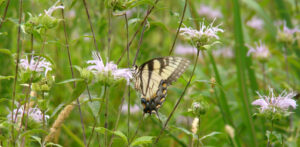
(An Eastern Tiger Swallowtail)
By Andrea Naccarato/DWR
Butterflies are fascinating creatures to observe in Virginia’s natural ecosystems, gardens, farms, and any other places where they can flutter from flower to flower.
Within the Animal Kingdom, butterflies are considered a type of insect because they have three pairs of legs and an exoskeleton.
Butterflies go through four major stages during their lives. For three out of those four stages, they don’t look anything like butterflies!
Stage #1 – Egg
Every butterfly life begins inside a tiny egg, about the size of a pinhead. Adult female butterflies generally lay their eggs on young leaves of specific kinds of plants, called “host plants.” Depending on the species, the eggs may appear in various colors, shapes, and textures. Using a magnifying lens helps one appreciate the beauty of these easily overlooked eggs.
Stage #2 – Caterpillar
A wingless, worm-like creature called a caterpillar (also referred to as a “larva”) is what hatches from the egg. Its head is equipped with jaws that are perfect for munching the young leaves and other soft parts of its host plant. Caterpillars move around and cling to their host plants using three pairs of true legs (near the head) and additional pairs of “prolegs” (near the rear end).
The caterpillar generally does not bear any resemblance to the butterfly it will become, although the caterpillar’s appearance changes drastically as it grows and sheds its skin multiple times. Depending on the species and growth stage (called an “instar”), caterpillar skin may appear translucent, camouflaged, colorful, or even spiky. Eventually, the caterpillar will find a safe location, hang upside down, and shed its skin one final time to reveal the third stage of its lifecycle: the chrysalis, also known as a “pupa.”
Stage #3 – Chrysalis
The chrysalis is often affixed to a plant stem or other sturdy structure, although some species’ chrysalises may be hidden in fallen leaves. The chrysalis may display eye-catching colors, like the jade green and metallic gold of the well-known monarch chrysalis, or they may blend in with surrounding dead leaves. Although the chrysalis is stuck in place, sometimes they can twitch suddenly to scare off potential predators!
Stage #4 – Adult Butterfly
After a few weeks to months of undergoing impressive bodily changes inside the chrysalis, a recognizable adult butterfly emerges. The fresh butterfly typically hangs by its legs off the remains of its chrysalis while its wings expand and it prepares for flying.
The large yellow butterfly with black tiger stripes (shown above) is Virginia’s state insect. There is one teardrop-shaped tail on the bottom of each hindwing, which is characteristic of most swallowtails.
The eastern tiger swallowtail may appear in two forms—the yellow form and the black (or “melanistic”) form. The melanistic form of this swallowtail occurs in females only and is believed to function as a survival strategy. This darker version of the eastern tiger swallowtail appears to mimic the pipevine swallowtail, which is toxic to predators.
Eastern tiger swallowtails can be found throughout Virginia in a variety of habitats. Females lay their eggs on the leaves of several types of trees, such as tulip tree, wild cherry, and ash trees.
There are so many more species out there! The next time you venture out in the spring or summer, keep your eyes out for these beautiful creatures. Besides brightening your day, their presence is extremely important to natural processes from food webs to pollination.

